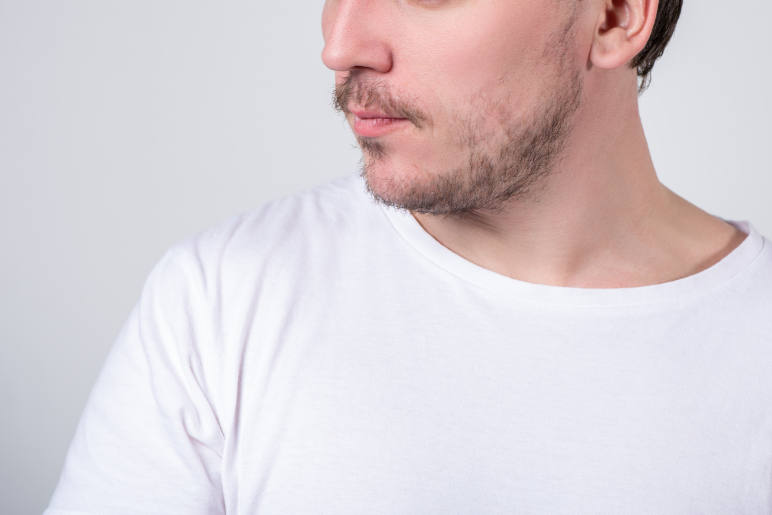
How To Fix Patchy Beard Growth and Grow a Full Beard
Facial hair grows on men’s faces because the hair follicles on your jawline are stimulated by testosterone. Women have the same amount of hair follicles on their faces as men, however, females have lower levels of testosterone. Thus, only men are capable of growing dense and full beards.
Beards are stimulated by testosterone, but on the contrary, patchy beard growth doesn’t mean that a man is lacking testosterone. Here we analyse the causes and how to fix a patchy beard.
What Causes a Patchy Beard?

Before we look at how to fix a patchy beard, we need to answer the question, “why is my beard patchy?”. Unfortunately, for some of us, patchy beard growth is just in our genetics, similar to hereditary hair loss. Thus, if you haven’t been born with the ability to grow a thick, full beard, then it’s simply not naturally possible.
A patchy beard is when some areas of a man’s face simply cannot grow beard hair, thus causing bald patches within their facial hair. Some people are able to make this patchy beard work for them using strategic styling techniques, as we’ll see below.
Male Hypogonadism
Hypogonadism in men refers to the inability to produce enough of the hormone testosterone that plays a vital role in masculine growth, especially during puberty. Such clinically low testosterone levels indicate testicular failure or an issue in the part of the brain that signals testosterone production.
Both of these types of Hypogonadism are either inherited or caused by an injury or infection. Either way, the incredibly low testosterone levels results in the facial hair follicles not being stimulated. Thus, it’s impossible to naturally grow any kind of beard or resulting in patchy beard growth.
Age
If you are looking for a patchy beard solution, and you are under 25 then it’s possible that your beard has not reached “full beard growing potential” yet. After puberty, your hormones change several times, which causes patchy beard growth. Therefore, try waiting a few years before trying again, and then leave your beard alone for 9 to 12 weeks to see if it gradually fills in.
Alopecia Areata Barbae
The autoimmune disease, Alopecia Areata, can also target facial hair – it’s then called Alopecia Areata Barbae. This condition causes bald patches within your beard because your body’s immune system mistakenly attacks your hair follicles. This can be the most difficult issue to treat patchy beard growth as the hair can unpredictably fall out again.
What Causes a Patchy Beard?
Growing facial hair that is as thick as you desire is a challenge – especially if your beard grows patchy. Even though the growth rate of beard hair is out of our control, there are techniques to try that can help stimulate growth.
In addition, many of us give up at the first hurdle and don’t allow our hair to grow for long enough. So, one of the first things you need to do is give yourself more time to allow the hairs to properly grow. It may be the case that your hairs just need a little more time to start growing without you shaving the hairs.
How Can I Fix my Patchy Beard?
1. Beard Oils
Natural oils and essential oils are effective at conditioning your beard hair, which nourish the strands and makes your beard look thicker. Oils such as castor oil and black cumin oil provide deep moisture to the strands. This doesn’t necessarily make your hair grow in the bald spots, but it will make the surrounding hair appear more conditioned in fixing your patchy beard appearance. Additionally, it can help in creating more effective patchy beard styles.
Cold-pressed castor oil is the most effective. This oil has been used for centuries as a hair growth remedy, especially in India. It’s well-known for its antibacterial, anti-inflammatory, and blood flow stimulation properties.
2. Minoxidil
Minoxidil (widely known as the main ingredient in Rogaine), is used for the treatment of scalp hair thinning, including male pattern baldness. Thus, men have been using it on their beards to try to improve their patchy beards and push their struggling facial hair growth towards thick beard hairs.
3. Facial Hair Transplant
A beard transplant is the best treatment to improve beard growth. Hairs from the back of your head are carefully, individually extracted using the FUE technique. Then those hair grafts are inserted into the areas with thinning hair in order to tackle patchy beard hair.
Once the hairs are inserted into your beard, they grow and blend into your surrounding beard hair. Thus, you’ll be able to grow a full beard like our satisfied clients.
4. Microneedling
Micro needling is a proven treatment for hair loss which can also be effective for beard hair. It’s a minimally invasive procedure that stimulates collagen production to help hair grow thicker in the treated area to achieve a fuller beard. Microneedling is typically paired with other patchy hair growth treatments as it has been known to promote those other methods.
5. Beard Hairbrush
Using a boar bristle beard hairbrush as part of your beard care routine elongates your hairs – especially when it’s used with a beard balm. This makes your facial hair appear fuller.
Using a beard brush alongside a beard trimmer will also allow you to shape your hair and keep it tidy. Chin straps, goatees and 5 o’clock shadow are the best styles to wear if you are trying to wear a patchy beard with confidence.
Conclusion
To stop your beard from being so patchy, first, identify what is causing it. Once you know the cause, you can choose the best treatment option for you.
Whether you want to cover your patchy beard growth with the surrounding hair or fill in the areas with a beard transplant, both options are available to you. Discover everything you need to know about modern transplants and why Turkey is a top destination for patients in our guide to hair transplants in Turkey.
FAQ
What are the common causes of patchy beard growth?
Common causes include genetics, hormonal imbalances, age, and autoimmune conditions such as alopecia areata.
How can diet impact beard growth?
A diet rich in vitamins and minerals like biotin, zinc, and vitamin D can promote healthier hair growth, including beard hair.
Can stress contribute to patchy beard growth?
Yes, high levels of stress can negatively impact hair growth by causing hormonal imbalances and affecting overall health.
What role does genetics play in beard growth?
Genetics is a significant factor in determining the density and growth pattern of facial hair. If patchy beard growth runs in the family, it is likely to impact you as well.
Is it possible to train beard hair to grow in patchy areas?
While hair cannot be trained to grow in patchy areas, regular grooming, using beard oils, and proper care can improve the appearance and health of existing hair.
What are some effective beard care routines to follow?
Effective routines include regular washing with a gentle shampoo, conditioning with beard oil, brushing with a boar bristle brush, and trimming to maintain shape and remove split ends.
How long should I wait before considering a beard transplant?
It’s recommended to wait until you are at least 25, as beard growth can continue to develop until that age. If patchiness persists past this age, the first step is to consult with a specialist.


